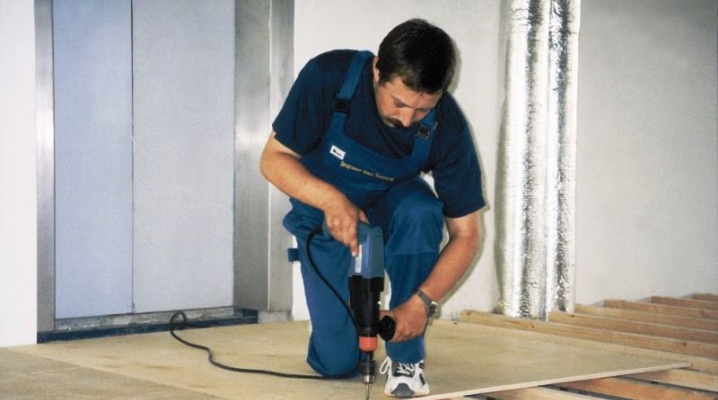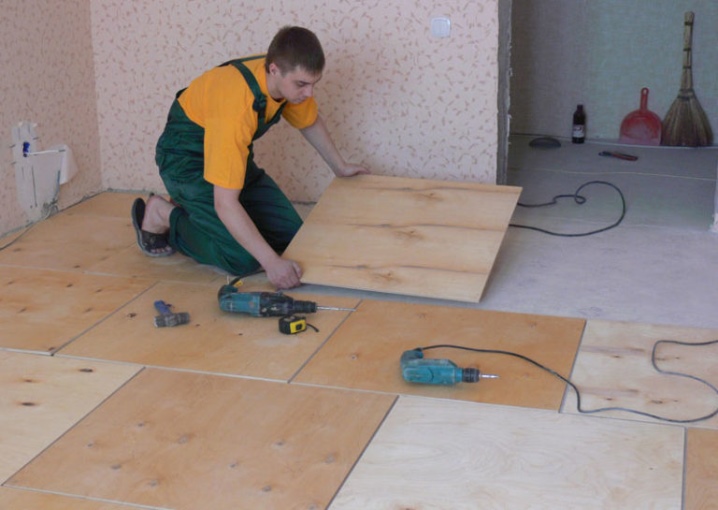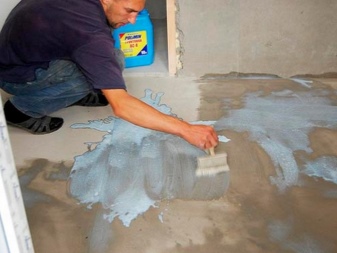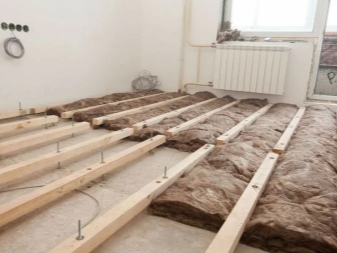Technology for laying plywood on a concrete floor

Often, when installing floors, finishing materials are used, the installation of which implies a perfectly flat base surface. Many owners of cottages and apartments, wishing to make their own home more comfortable for living, practice warmer materials for leveling the floor, not cement screed.
A particularly popular option is considered to be plywood covering a concrete base for linoleum, parquet or laminate. The use of laminated laminated wood is due to the presence of a lot of positive qualities in it. The material is affordable and easy to install. In the article we will describe how to correctly perform the work, and what materials can be used in this case.

Fundamental rules
There are a number of key rules for laying plywood on a concrete base (flooring, floor):
- the floor must be clean and dry;
- in order to increase protection against water penetration, a specialized substrate or a dense cellophane film is used - it covers the entire floor area with an overlap, the seams are fastened with ordinary tape;
- a large solid sheet should be laid from the threshold, since this place will have the greatest load, and joints are not recommended;
- plywood sheets are stacked offset so that the seams do not form a single line, leaving a small gap;
- plywood is not easy to nail to a concrete floor, therefore, it will not do without a hammer drill, it is necessary to drill with carbide drills;
- the caps of the self-tapping screws should be slightly larger than the diameter of the drill so that the self-tapping screw does not pass through the material;
- plastic dowels are installed in the drilled holes, into which self-tapping screws are screwed;
- plywood sheets are fixed in the center and along the contour;
- the excess length of the sheet is cut off with an electric jigsaw;
- at the end of the installation, inspect whether all the screws are well recessed so as not to spoil the floor covering - cork, linoleum or carpet.

Materials (edit)
There are several types of plywood on the floor. So, there is a material with water-repellent characteristics. In the production of these sheets, thin layers (sheets) of wood are used, which are glued together with specialized synthetic resin glue. Such plywood can be easily used in residential premises.


There is also plywood that has not been pre-sanded. After installing this material, grinding is performed. Finally, there is plywood that is processed only on the front side. In terms of the thickness of these sheets, which are fixed to the concrete base, it should be at least 1.2 centimeters.

Varieties of adhesives for plywood
The choice of the adhesive composition is no less important, since the laying technology and the final result largely depend on this. Laying the material on a concrete base involves the use of specialized adhesives. The safest is water-based glue. This product is odorless and can be mixed with plain water. However, this substance dries out rather slowly. A similar adhesive composition is used in conjunction with dowel-nails.
Solvent based adhesive is acceptable and will dry within 2 days. When using it, additional fasteners in the form of nail dowels are also required. The disadvantage of this glue is a pungent smell.
The fastest installation is done with a 2-component adhesive. It dries up completely within 24 hours. The use of dowels is optional.

Mounting methods
There are two ways to attach plywood to a concrete base:
- using an adhesive composition, when installation is carried out directly on a concrete base;
- when the quality of the base is far from ideal, you can perform installation on logs.
In addition to differences in the method of laying, these technologies make it possible to eliminate a variety of problems. They are selected based on the need to solve a specific problem.


How to do it yourself?
Before proceeding with the installation of plywood, preparatory measures are required.

Preparation
First of all, it is required to check the evenness of the concrete base by means of a level - if impressive differences are observed (more than 5 millimeters), then additional alignment with a cement-sand screed is necessary. If everything was done correctly, and the base is flat, then they are taken for surface preparation.

First of all, it is necessary to check whether the concrete is dry, since it is undesirable to lay plywood on wet material. To do this, lay a cellophane film on the floor, press it down along the edges, and leave it for 8-12 hours. The formation of condensation indicates that the concrete is still wet, the cellophane surface must be absolutely dry, which indicates that the screed is completely dry.

The surface is cleaned of dirt and dust, all greasy spots are removed - otherwise they will interfere with the adhesion of materials, the plywood in this area simply will not stick.

After cleaning the floors, they are taken for the application of a primer. To do this, use a ready-made primer (impregnation) for deep penetration concrete, or take an adhesive composition that will be used for gluing plywood, dissolve it with a specialized solvent. The primer is applied with a roller or a paint brush. It is unreasonable to ignore this process, since impregnation not only improves the adhesion properties, but also additionally strengthens the surface, counteracts the absorption of the adhesive composition by concrete, which significantly reduces its consumption, absorbs dust. When purchasing an impregnation, pay attention to its structure, it should contain antifungal additives.


It is extremely important to choose the right plywood, in thickness it should be from 12 to 15 millimeters. In such a case, it is advisable to use moisture-resistant sheets, which are made on the basis of thin sheets and synthetic resin glue, this plywood should not contain phenol. As mentioned above, plywood can be unpolished and sanded, unpolished is additionally processed after installation on a cement screed.

Mounting
After cutting the sheets and applying the impregnation, you can start laying. It is necessary to rely on the previously made numbering. The procedure is carried out in several stages.
- An adhesive composition is applied to the concrete base. The layer thickness should not exceed 2 millimeters. Experts advise to apply the composition to not very large areas so that there is time to put the plywood on before the glue sets.
- Pieces of plywood are laid on the processed base according to a certain pattern.
- Then the sheets are fixed with self-tapping screws. Sheets are required to be screwed along the entire contour and diagonally. The step should be from 15 to 20 cm. The maximum distance from the edges of the floor is 2 cm. Self-tapping screws should be used 3 times the thickness of the sheets used in length. For example, sheets with a thickness of 12 mm should be fastened with self-tapping screws 40 mm long.
- The laid plywood is processed with a sander with the proper attachment. You can also process it manually using sandpaper (however, if the area is considerable, you should still use the tool). Thanks to this procedure, we will equalize the discrepancies in the height of adjacent sheets and remove burrs.


Installation of logs on a concrete base for plywood
Before that, we analyzed the installation method without lag. It is quite simple, but you can only practice it when you need to cover small irregularities. When the floor is not in the measure of a curve or it is planned to install a warm floor, just this method is chosen. The most important thing is that the lags are set correctly. To control their position, you must use a level and a ruler.
Here, too, the preparation of the base is first carried out. If this is a stale screed, it must be cleaned without residue from the previous coating: carpet, laminate or linoleum. Check for cracks in the plane. If there are any, use a cement solution and cover up the damage. Then you need a backing. For this, you can use ordinary cellophane. Only the film must be airtight and complete - otherwise it will not give any result. The edges of the film are fixed with tape.

Further such actions are performed.
- The lowest point in the room is found. Actually, from here and it is necessary to begin the installation of the lag. They are mounted at right angles to the incident light. In this case, the distance between the lags should not be more than 50 cm. It is also envisaged that the seams of the sheets will be on the lags.
- The lags are fixed to the concrete floor with anchors.
- A crate is made between the lag.
- Thermal insulation is being installed. It fits into the mesh of the crate.


Keep in mind that mounting a log on a concrete base under plywood has its own characteristics. So, the thickness of moisture-resistant plywood should be at least 18 mm. A 2 mm gap is left between the sheets. In the future, it must be filled with putty. Clearances are needed in order to prevent warping of the base, and, of course, the appearance of a squeak when walking. As for the fastening material, self-tapping screws are used as it. As mentioned earlier, in length they should be 3 times the thickness of the plywood sheet.
However, one should not forget that when plywood is mounted on a concrete base with the help of a crate, the ceiling height is reduced. And if the ceilings in the room are low, it is advisable to refuse this method and deplan the surface in a different way.


Checking the quality of work
After the installation of plywood on a concrete base has been completed, it is necessary to carefully examine the surface. The most important thing is that the plywood does not come into contact with the walls. Expansion joints must be provided on all sides. You also need to make sure that there are no differences in height. A difference of 2 millimeters is allowed, but not more. In addition, after installation, the wooden flooring should be tapped with a mallet. If there is a heterogeneous dull sound, you will need to correct the work. This sound indicates material delamination from the concrete.

Final alignment
Small plywood sheets during installation can be installed unevenly in relation to each other. Here, both the unevenness of the base itself and the uneven attraction of various sections of the plywood with fasteners can affect.
Soft flooring - linoleum and carpet - will show all the flaws noted after a certain time of use. Rigid cladding - laminate, parquet - can break under loads on deficient areas.

To level the surface, after filling the joints with a sealant and puttingtying, the entire plane of the rough base is either sanded, or cycled, or both, based on the material to be installed and the size of the irregularities.


For information on how to lay plywood on a concrete floor, see the next video.













The comment was sent successfully.